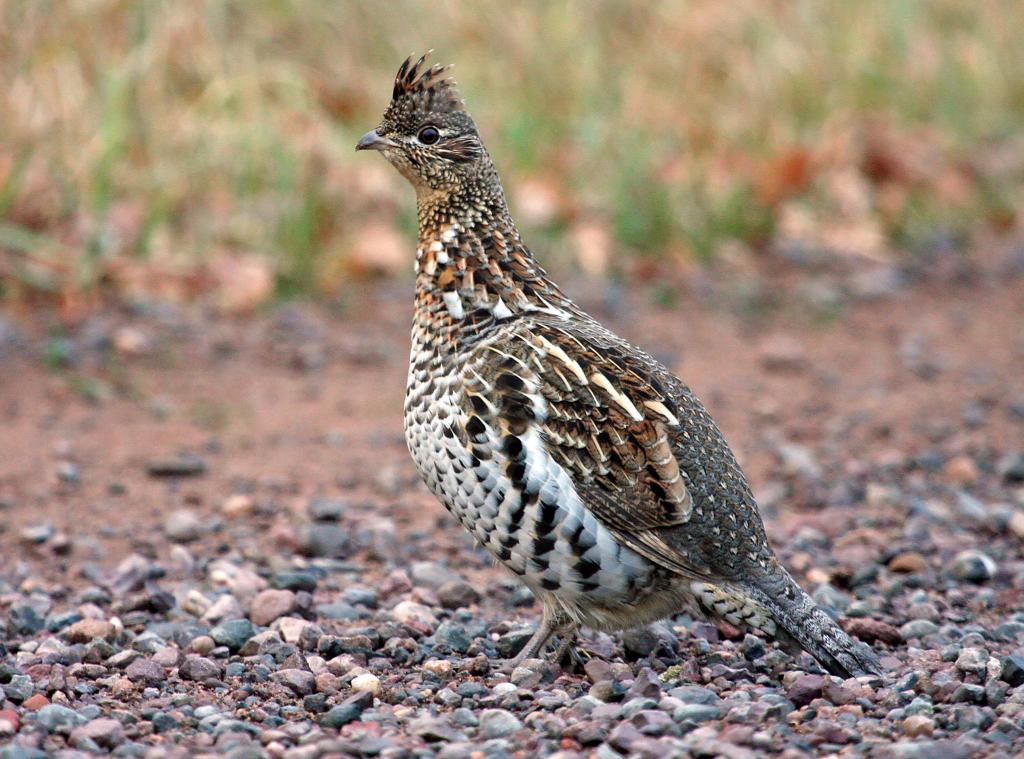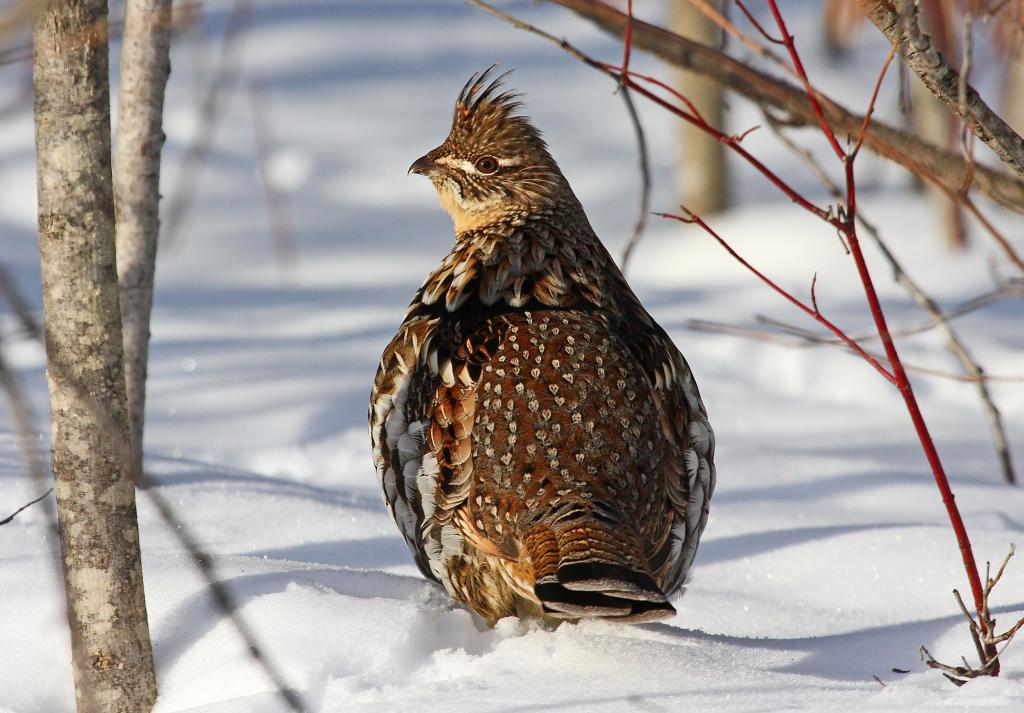Ruffed grouse hunting
INFORMATION ON RUFFED GROUSE AND HPAI
In the spring of 2022, a strain of highly pathogenic avian influenza (HPAI) was detected in numerous domestic and wild birds throughout Wisconsin. It is expected that the virus will continue to circulate in wild bird populations this year. In general, upland birds such as ruffed grouse have behaviors and prefer habitats that make them less likely to encounter avian influenza viruses in the wild.
Hunters should never harvest wild birds that appear sick. If you observe a ruffed grouse that appears ill, contact the DNR's Wildlife Switchboard by emailing DNRWildlifeSwitchboard@wisconsin.gov or by leaving a voicemail for a return phone call at 608-267-0866.
This strain of HPAI does not pose a food safety risk. However, hunters should always ensure the proper handling of game meat. Harvested birds should be cooked to an internal temperature of 165°F.
Additional recommendations for hunters are on the USDA website. Visit the DNR's wildlife diseases page for more information on avian influenza and other diseases affecting wildlife health.
Season information
Season dates
- Ruffed grouse season dates
- Ruffed grouse hunting zones
- Fall 2024 - Spring 2025 Combined Hunting Regulations
Regulations
- Small game hunting regulations
- Harvest Information Program (HIP)
- Many hunters pursue ruffed grouse and woodcock at the same time. If you plan to hunt woodcock or other migratory birds as a mixed bag, you must be HIP certified and follow the migratory game bird hunting regulations.
- Grouse identification guide
- Spruce grouse are a state-threatened species found in many of the same areas as ruffed grouse. Be sure you know the difference between the species to avoid the accidental harvest of spruce grouse.
Where to hunt
Find the best habitat
Ruffed grouse use various habitat types, but young, early successional forest types are most important when finding a good grouse hunting spot. Seeking out the densest woody cover available is usually the quickest way to locate grouse in a new hunting area.
- Fields & Forest Lands Interactive Gamebird Hunting Tool (FFLIGHT)
- Use this interactive map to find public land and suitable habitat for grouse and woodcock.
- Grouse hunting maps in Wisconsin county forests
- The Wisconsin County Forest Association created a collection of maps showing various ruffed grouse management areas on county-owned forests throughout Wisconsin.
- Chequamegon-Nicolet National Forest
- The Chequamegon-Nicolet National Forest is over 1.5 million acres in northern Wisconsin open to outdoor recreation, including hunting, fishing and camping. See the website or contact the forest headquarters office for more information.
- Public land access
- From hunting and fishing to camping and hiking, use this resource to find everything you need to enjoy the outdoors.
Disease sampling
West Nile Virus Sampling Project 2018-2021
2021 was the fourth and final year of a region-wide effort to understand better the West Nile virus in ruffed grouse in Michigan, Minnesota and Wisconsin. The primary objectives of this multi-year monitoring effort were to:
- Assess the feasibility of utilizing hunter-harvested ruffed grouse to obtain biological samples from harvested birds for disease screening and collecting relevant metadata.
- Determine the prevalence of exposure to WNV in ruffed grouse populations and if there is a significant change by year in Wisconsin.
- Evaluate whether samples can be collected sufficiently to assess prevalence across different state regions.
- Examine submitted samples for evidence of clinical disease associated with WNV infection.
Self-sampling kits
Thank you to all hunters who submitted a self-sampling kit for the 2018-2021 seasons; a final report on results by year can be found below.
Management
Ruffed grouse management
The department has taken a proactive and collaborative approach to ruffed grouse management, emphasizing increasing available habitat, developing partnerships and outreach strategies, engaging private landowners, monitoring the population through surveys and providing tools to improve the hunter experience on public lands.
Ruffed grouse thrive in young, early successional forests, which is why the Wisconsin Department of Natural Resources has taken a proactive and highly collaborative approach to ruffed grouse management and young forest habitat management in general.
As forest ownership and use continue shifting from large, working forests to small, non-industrial private forests, the importance of active young forest management on public and private lands has grown. Wisconsin DNR has taken numerous steps to address conservation challenges associated with grouse habitat, including active young forest management on state lands, extensive public outreach efforts and establishing strong partnerships to deliver technical and financial assistance to private landowners.
Ruffed Grouse Management Plan
In September 2018, an ad hoc committee was formed to create Wisconsin's ruffed grouse management plan. The Natural Resources Board approved the Wisconsin Ruffed Grouse Management Plan 2020-2030 on Dec. 11, 2019.
Ruffed Grouse Advisory Committee
The Ruffed Grouse & Woodcock Advisory Committee, a diverse group representing government agencies, non-governmental organizations, tribal interests and conservation groups, meet to discuss issues relating to ruffed grouse and woodcock management and young forest management in Wisconsin.
The Ruffed Grouse & Woodcock Advisory Committee reviews and makes recommendations on managing ruffed grouse and woodcock in Wisconsin. The Committee advises the Wildlife Policy Team on various topics such as hunting regulations, surveys and research priorities.
- April 1, 2024 Meeting Minutes
- April 12, 2023 Meeting Minutes
- April 14, 2020 Meeting Minutes
- Upcoming meeting dates
Habitat partnerships
The department collaborates with various partner groups to promote young forest management on both state-owned and privately-owned land. One part of these partnerships is to provide private landowners with technical and financial assistance to manage their property for young forests, which benefits ruffed grouse. See below for more information on these partnerships.
- Young Forest Initiative
- In 2011, the DNR helped launch the Wisconsin Young Forest Partnership to educate and engage landowners on active forest management and to provide landowners with the technical and financial assistance needed to create young forest habitats that will benefit ruffed grouse and other early successional wildlife species.
- Wisconsin forest wildlife specialists
- The DNR partners with the Ruffed Grouse Society and USDA - Natural Resource Conservation Service to support two forest wildlife specialists in Wisconsin. These specialists promote young forest habitats on private lands by offering landowners technical assistance and Farm Bill conservation program enrollment.
Surveys
Population trends
Each year, biologists, wardens, foresters, members of the Ruffed Grouse Society, and other volunteers conduct ruffed grouse drumming surveys and summer brood surveys throughout Wisconsin. Ruffed grouse drumming surveys have been conducted since 1964, and brood surveys have been undertaken since 1970. Other ruffed grouse surveys include the annual small game harvest survey and the summer wildlife inquiry. Together, these surveys provide information on ruffed grouse production and population trends.
The ruffed grouse population is known to cycle on a 9-11-year cycle, with peak population numbers typically in years that end with 9, 0 or 1. Over the last 50 years, the drumming and brood surveys indicate an overall downward trend in the grouse population, with the cyclical highs not as high as in the past. This trend is likely the result of the long-term aging of Wisconsin's forests.


